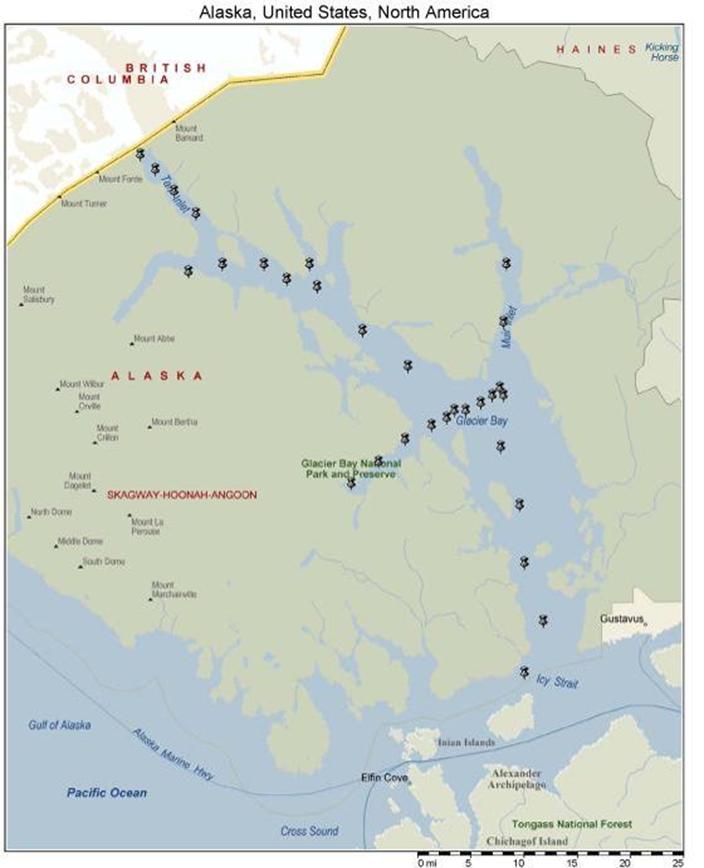|
Click on the question mark to ask the class about oceanography, Glacier Bay, or the cruise. Your question and answer will appear on the Questions page under Quick Links. |

|
6:30 AM After over 82 hours in transit through the Inside Passage we reached our first station just outside of Glacier Bay proper at 5:30 AM. This was 3.5 hours earlier than our last estimate, and almost 6.5 hours earlier than the original cruise plan called for. Everyone breathed a sigh of relief as projects in danger of being cut were brought back into the plan.
After our first two stations outside the bay are complete, we will head to the NPS dock at Bartlett Cove. There we will receive a briefing from the NPS, give tours of the Thompson to local school children, and take on several staff researchers from the NPS.
The below map shows all of our stations within Glacier Bay for the next four days. Many of these stations will need to be visited more than once, to recover deployed equipment or to develop a time series (multiple data points from the same location taken at different times).
-Jeff
|
|
March 18, 2008 |



|
Deploying gear in the snow at the first station. The large bottle going over the side is a 30 L capacity “GO-FLO” bottle, which collects water for low concentration nutrient and trace metals analysis. |

|
A very confused shorebird makes a friend, after blundering into the side of the Thompson. |



|
Brandon and Jusin remove a casting core from the coring rig, a delicate task. Any disruption to the stratification of the sediment will make analysis difficult. |

|
Snow and ice all around, we had snow flurries throughout the day. |

|
School kids from some of the town of Gustavus met the Thompson at the NPS dock for a tour. |

|
Not all of our projects are strictly marine. With a little help from a NPS scientist and TA Eric, Vikki and Christina drill through the ice of a small pond to collect sediment. |

|
Baleen whales are rare in SE Alaska this time of year, but this lonely humback swam by while we were on station. |

|
Thalassionema nitzschioides, a phytoplankton identified from a net tow earlier today. |

|
Psuedo-nitschia pseudodelicatissima, another phytoplankton from the same net tow. |
|
8:25 AM First day of shifts and science...
We started our science shifts this morning at 6am Seattle time. Also starting then we have been told to conserve water because we can't dump our "gray water" into Glacier Bay. Gray water is the term given to all water that is used and treated on the ship such as water for showers, sinks, and the galley (kitchen). Since we cannot dump this water into the bay, if the ship reaches it's holding capacity we will have to leave the bay and loose precious science time.
We reached station 00 about 5:45am and the maddness began... "get the CTD ready for deployment!" "Marcus, how many Go-Flo bottles are you sending down?" "Where's the hand net?" But all in all the sampling went smoothly and set us up for a great start to science.
We did have a few little casualties though... some very cute little gull-like birds came flocking towards the fantail lights that came on when we got on station. The bright lights on their nocturnal eyes made them very confused which unfortunately made them very sick. One flew into the staging bay and was standing right next to me. He kept walking into stuff because his vision was so compromised and then threw up his dinner! He even let us pick him up and carry him off the ship.
The second station we got to was much less eventful. We quickly got our CTD done and were on our way to Bartlett Cove where we actually get to dock and plant our feet on Alaskan soil for a while. Also there we are going to give tours to the local school kids. We're all looking forward to meeting them and sharing our Alaskan experience!
~Cathy
|
|
Quick Links
Senior Thesis Research Course, Ocean 444
Senior Thesis Planning Course, Ocean 443
Quick Links to Blog Entries
|
|
Glacier Bay banner background image by Andy Cameron, see original image. Send mail to: seniorcruise2008@ocean.washington.edu |